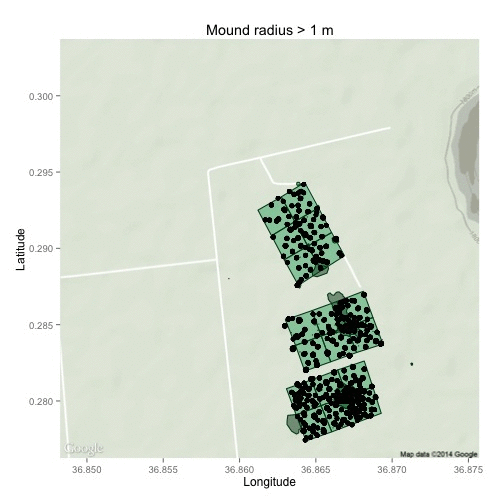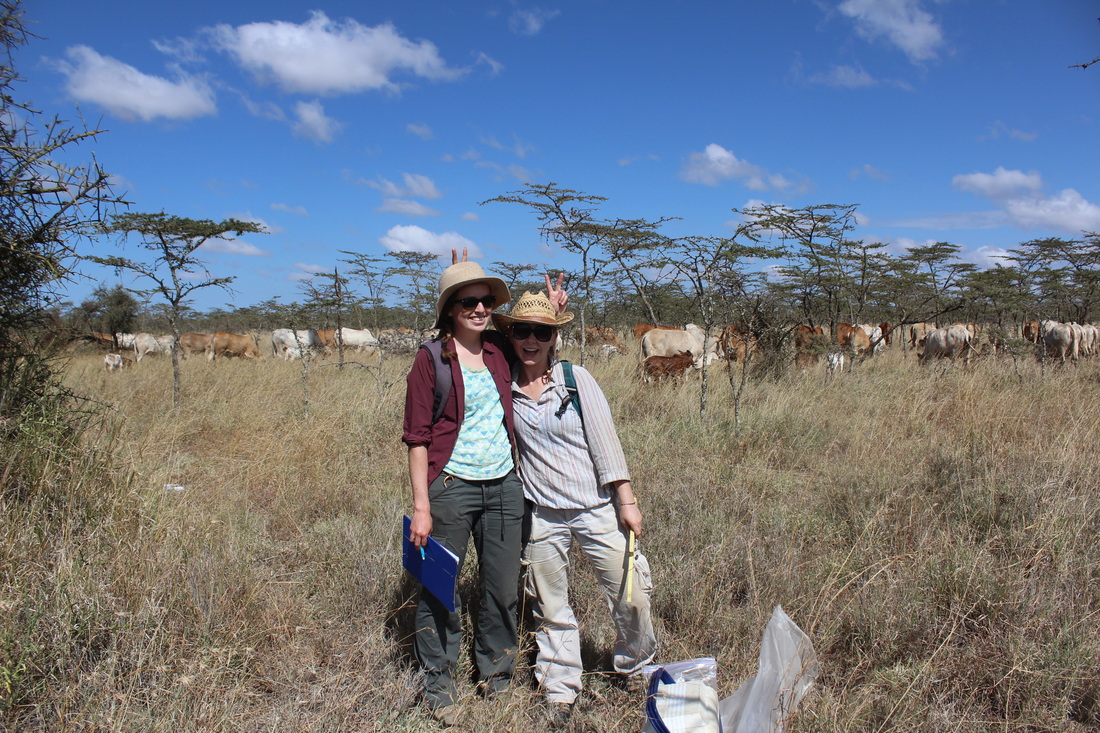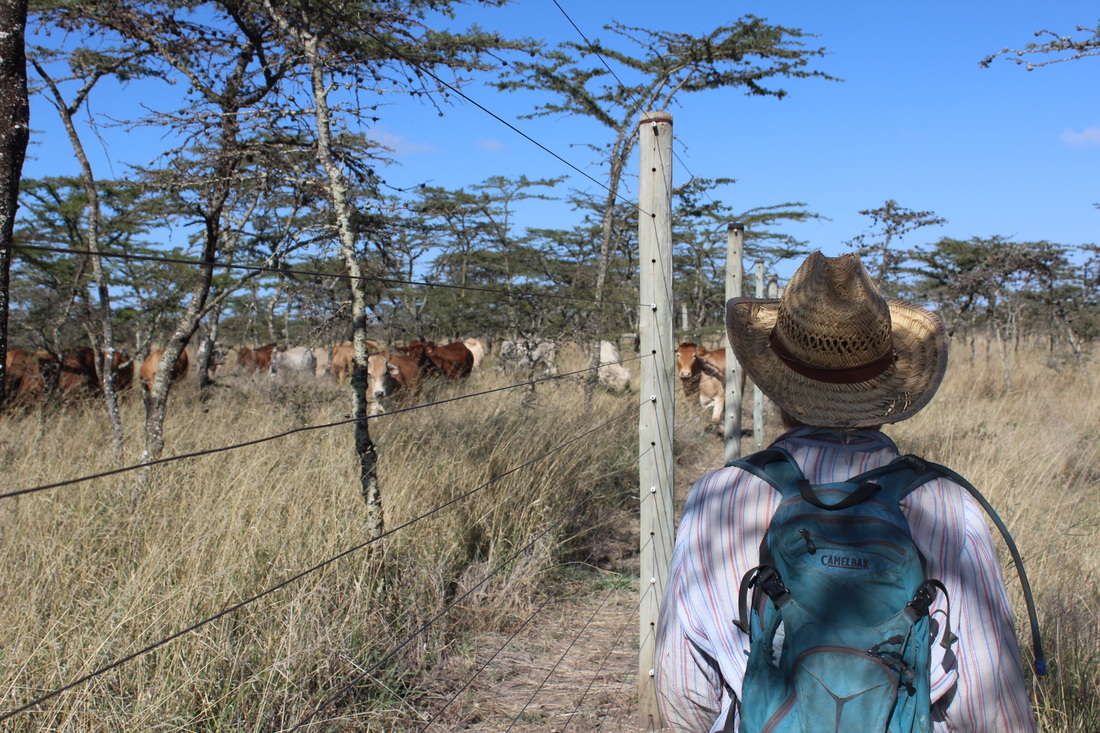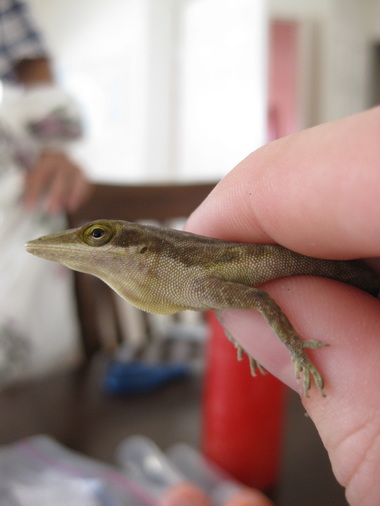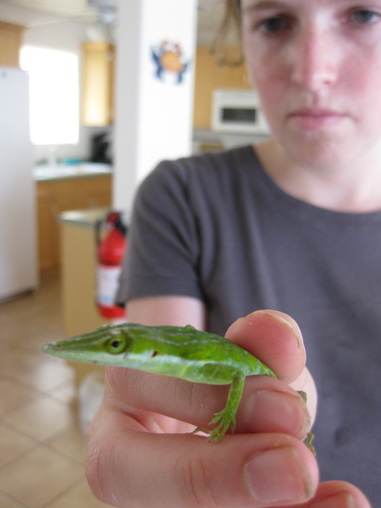Keystone species in savannas
For the last few years, I've been asking questions about the importance of keystone species on savanna ecosystems. A keystone species is one that has a disproportionately large effect on an environment relative to its population size. Some good examples of keystone species are beavers and their creation of beaver dams, or top predators such as the wolves in Yellowstone.
Who are the keystones of savannas? Your first thought might be large mammals, and with good reason: large mammals in savannas drive patterns in biodiversity and other important ecosystem functions. I have worked on two long-term experiments that are uncovering the role of large mammals as keystone species.
The UHURU experiment (Ungulate Herbivore Under Rainfall Uncertainty) examines the effects of different groups of large herbivores and different rainfall patterns on savannas. I have collaborated with UHURU since 2010, including a year from 2011-2012 I spent managing this experiment at Mpala Research Centre in Kenya.
Relevant UHURU work:
I now conduct most of my research in the Kenya Long-term Exclosure Experiment (KLEE), also based at Mpala Research Centre. I am interested in similar questions, but have become fascinated by another important keystone species: the lowly (yet mighty!) termite. I am particularly interested in understanding if and how termites and large herbivores interact through their shared food resources. I've done extensive mapping of termite mounds within KLEE to ask if and how herbivores affect termite abundance and distribution.Some takeaways so far?
This work is part of my dissertation and is currently in preparation for publication. I'll be in the field in fall 2016 to take some isotope measurements of termites in hopes of better understanding if colonies can shift feeding strategies in response to resource availability.
Take a look at a map I created of termite mounds within KLEE:
For the last few years, I've been asking questions about the importance of keystone species on savanna ecosystems. A keystone species is one that has a disproportionately large effect on an environment relative to its population size. Some good examples of keystone species are beavers and their creation of beaver dams, or top predators such as the wolves in Yellowstone.
Who are the keystones of savannas? Your first thought might be large mammals, and with good reason: large mammals in savannas drive patterns in biodiversity and other important ecosystem functions. I have worked on two long-term experiments that are uncovering the role of large mammals as keystone species.
The UHURU experiment (Ungulate Herbivore Under Rainfall Uncertainty) examines the effects of different groups of large herbivores and different rainfall patterns on savannas. I have collaborated with UHURU since 2010, including a year from 2011-2012 I spent managing this experiment at Mpala Research Centre in Kenya.
Relevant UHURU work:
- Piecewise disassembly of a large-herbivore community across a rainfall gradient: the UHURU experiment
- Low functional redundancy among mammalian browsers in regulating an encroaching shrub (Solanum campylacanthum) in African savannah
- Plant and small‐mammal responses to large‐herbivore exclusion in an African savanna: five years of the UHURU experiment
I now conduct most of my research in the Kenya Long-term Exclosure Experiment (KLEE), also based at Mpala Research Centre. I am interested in similar questions, but have become fascinated by another important keystone species: the lowly (yet mighty!) termite. I am particularly interested in understanding if and how termites and large herbivores interact through their shared food resources. I've done extensive mapping of termite mounds within KLEE to ask if and how herbivores affect termite abundance and distribution.Some takeaways so far?
- Termites seem to shift rapidly in response to changes in resources.
- Termites love trees
- Termites also love cattle(?!)
This work is part of my dissertation and is currently in preparation for publication. I'll be in the field in fall 2016 to take some isotope measurements of termites in hopes of better understanding if colonies can shift feeding strategies in response to resource availability.
Take a look at a map I created of termite mounds within KLEE:
Are all herbivores created equal? Effects of different herbivore guilds on ecosystem function
We know that large herbivores can impact vegetative communities, but are all plant-eaters created equal? Maybe you're thinking, "of course there are differences between different animals!" On the other hand, maybe you're wondering if animals with similar diets (e.g., zebras and cattle) do impact ecosystems similarly.
Along with other members of KLEE, I am currently quantifying the effects of large herbivores on one exceedingly important ecosystem function: productivity. You can think of this project as the "sure, herbivores eat plants, but do they all eat them in the same way?" experiment. Results from this study were recently accepted into Ecological Applications.
Relevant work:
We know that large herbivores can impact vegetative communities, but are all plant-eaters created equal? Maybe you're thinking, "of course there are differences between different animals!" On the other hand, maybe you're wondering if animals with similar diets (e.g., zebras and cattle) do impact ecosystems similarly.
Along with other members of KLEE, I am currently quantifying the effects of large herbivores on one exceedingly important ecosystem function: productivity. You can think of this project as the "sure, herbivores eat plants, but do they all eat them in the same way?" experiment. Results from this study were recently accepted into Ecological Applications.
Relevant work:
Plant functional traits
I advised REU student Sara Germain in summer 2015 to create a functional trait library for the most common herbaceous plants in KLEE. Sara is currently writing these results up as her senior honor's thesis. We are soon collaborating with Chhaya Werner of the Young lab to ask about the evolutionary underpinnings of differences between plots.
I advised REU student Sara Germain in summer 2015 to create a functional trait library for the most common herbaceous plants in KLEE. Sara is currently writing these results up as her senior honor's thesis. We are soon collaborating with Chhaya Werner of the Young lab to ask about the evolutionary underpinnings of differences between plots.
Behavioral ecology
In a previous life as an undergraduate researcher, I studied the behavioral ecology of Anolis lizards. I worked with Dr. Terry Ord (now a senior lecturer at UNSW) to investigate the mysteries and plasticity of these lizards' social lives. We found that anole lizards have evolved different adaptive communication strategies for different "noisy" environmental conditions. I also found a nifty link between male tail crests and signalling strategies.
Relevant lizard pictures:
Relevant lizard papers:
- The Evolution of Alternative Adaptive Strategies for Effective Communication in Noisy Environments (The American Naturalist)
- Factors leading to the evolution and maintenance of a male ornament in territorial species (Behavioral Ecology and Sociobiology)
- Plasticity in social communication and its implications for the colonization of novel habitats (Behavioral Ecology)
